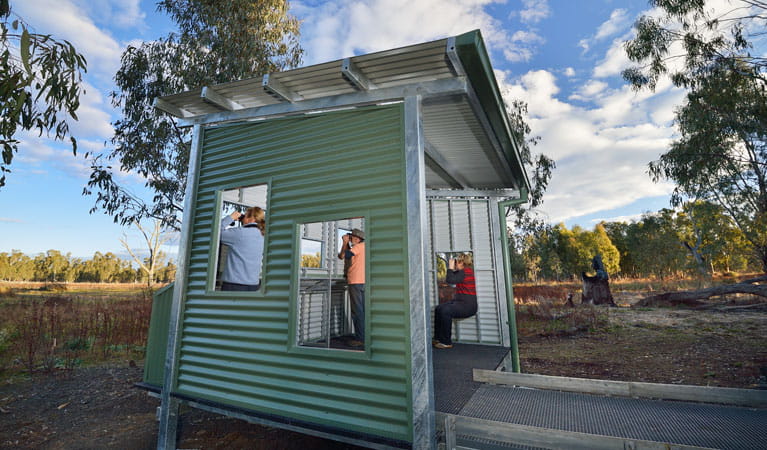Turkey Flat picnic area and bird hide
Murrumbidgee Valley National Park
Overview
Set on Murrumbidgee River, Turkey Flat picnic area and bird hide is a great picnic spot. Visiting these NSW wetlands is a top choice for things to do in Leeton.
- Type
- Picnic areas
- Accessibility
- Medium
- Opening times
- Turkey Flat picnic area and bird hide is always open, but may have to close at times due to poor weather or fire danger.
- What to
bring - Hat, drinking water, sunscreen
- Please note
- The weather in this area can be extreme and unpredictable, so please ensure you’re well-prepared for your visit.
- There is limited mobile reception in this park
- Remember to take your binoculars if you want to go bird watching
Located on the Murrumbidgee River floodplain, Turkey Flat is a site of global bird conservation importance and listed in the Directory of Important Wetlands. Plus, it’s one of only a handful of places where you’ll find a bird hide set amongst an ample forest of protected river red gums.
Why not come along and discover for yourself why this place is so special? Pack your hamper, binoculars and camera and check out the birds’ natural behaviour through the camouflage of the bird hide. From spoonbills to swamphens to sandpipers, there’s a world of birds awaiting you, though visiting after heavy rain offers the best birdwatching experience.
Turkey Flat picnic area and bird hide is a great option when you’re looking for things to do in Leeton. Look out for reptiles and kangaroos, peruse the interpretive panels and remember to use the bird ID sign to confirm which species you’ve spotted. You can also use your smartphone to scan QR codes to hear the calls of birds and frogs in the wetland area.
Why not visit at various times throughout the year to see how the resident bird population and landscape colours change with the seasons?
Map
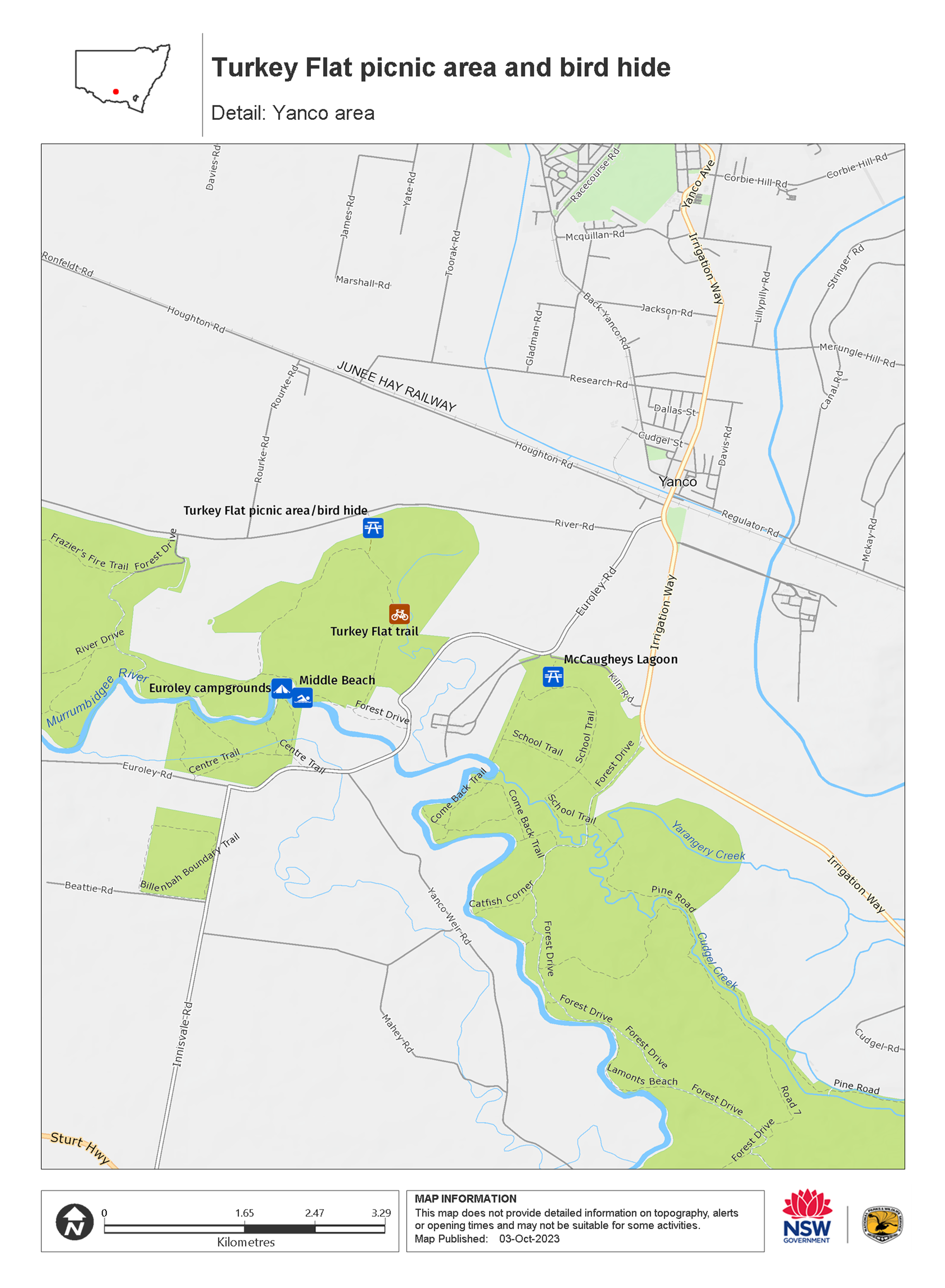
Map legend

Local alerts
For the latest updates on fires, closures and other alerts in this area, see https://www.nationalparks.nsw.gov.au/things-to-do/picnic-areas/turkey-flat-picnic-area-and-bird-hide/local-alerts
General enquiries
- National Parks Contact Centre
- 7am to 7pm daily
- 1300 072 757 (13000 PARKS) for the cost of a local call within Australia excluding mobiles
- parks.info@environment.nsw.gov.au
Park info
- in Murrumbidgee Valley National Park in the Murray-Riverina region
Murrumbidgee Valley National Park is always open but may have to close at times due to poor weather or fire danger.
Visitor info
All the practical information you need to know about the Turkey Flat picnic area and bird hide.
Getting there and parking
Turkey Flat picnic area and bird hide is in the MIA 2 precinct of Murrumbidgee Valley National Park.
To get there from Leeton:
- Drive east towards Narrandera on Irrigation Way
- Head through the township of Yanco and, just after crossing the train line, turn right onto Euroley Road.
- Continue down Euroley Road for 400m and turn right onto River Road
- Follow River Road for 2.5km – the entrance to Turkey Flat Wetland and the picnic area is on the left.
Road quality
Check the weather before you set out as the road to Turkey Flat picnic area and bird hide can become boggy when it rains.
- Unsealed roads
Vehicle access
- 2WD vehicles
Weather restrictions
- Dry weather only
Parking
Car and bus parking is available at Turkey Flat Wetland carpark, a roadbase carpark that's a short walk from Turkey Flat picnic area and bird hide.
Best times to visit
There are lots of great things waiting for you in Murrumbidgee Valley National Park. Here are some of the highlights.
Autumn
Evenings can be balmy at this time of year, so it's still a great time to camp.
Spring
Picturesque morning mists are common at this time of year and birds and animals are most active.
Summer
Enjoy early morning and late afternoon swimming during these hotter months.
Winter
This is Murray crayfish season, and a great time to head to the river.
Weather, temperature and rainfall
Summer temperature
Average
16°C and 32°C
Highest recorded
47.7°C
Winter temperature
Average
4°C and 16.5°C
Lowest recorded
-4.8°C
Rainfall
Wettest month
May
Driest month
January
The area’s highest recorded rainfall in one day
93.3mm
Facilities
- Drinking water is not available in this area, so it’s a good idea to bring your own.
- You’re encouraged to bring gas or fuel stoves, especially in summer during the fire season.
Picnic tables
Carpark
Step-free access
The picnic area is flat and step-free, with a 2m-wide roadbase path that leads from the carpark to the bird hide. This path becomes a raised fibre-reinforced plastic walkway that leads into the bird hide.
- Step-free outdoor pathways
Maps and downloads
Accessibility
Disability access level - medium
- Turkey Flat picnic area and bird hide is flat and step-free.
- There's a roadbase path that leads from the carpark to the bird hide and a raised walkway that leads into the bird hide.
- There's a picnic table near the carpark where you can rest. There may be a lip from the surrounding roadbase ground onto the concrete slab that the picnic table sits on.
Prohibited
Pets
Pets and domestic animals (other than certified assistance animals) are not permitted. Find out which regional parks allow dog walking and see the pets in parks policy for more information.
Smoking
NSW national parks are no smoking areas.
Learn more
Turkey Flat picnic area and bird hide is in Murrumbidgee Valley National Park. Here are just some of the reasons why this park is special:
River redgum
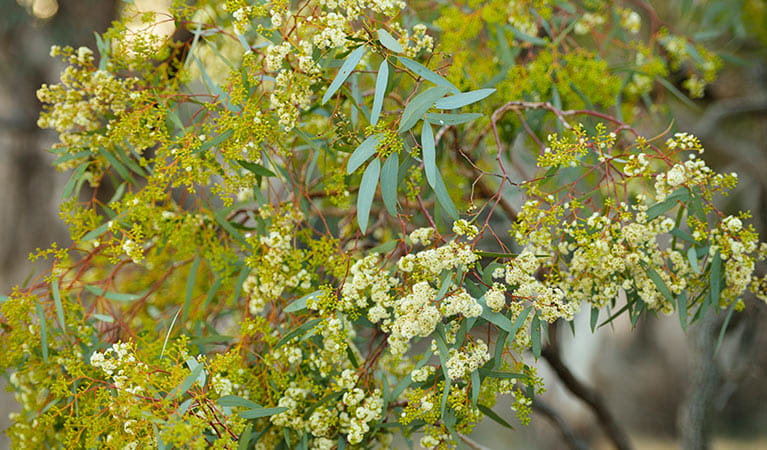
Murrumbidgee Valley National Park is synonymous with Riverina river redgum forests – an iconic Australian eucalypt which grows to awe-inspiring heights. With a deep red colour curving along rivers and channels, Riverina river red gum is of international significance. These special eucalypts provide a home to koalas, which you may spot in their branches. Bird watchers might catch a glimpse of white-bellied sea eagles, sacred kingfishers, and threatened superb parrots, amid the majestic trees. There are plenty of fishing opportunities available in the park too, with yellow belly, redfin and brim fish to catch in the area. Murrumbidgee Valley is also a sanctuary for reptiles and kangaroos.
- Forest drive If you’re looking for a scenic day trip near Murrumbidgee River, near Narrandera, go 4WDing or mountain biking along Forest drive, in Murrumbidgee Valley National Park.
- Turkey Flat picnic area and bird hide Set on Murrumbidgee River, Turkey Flat picnic area and bird hide is a great picnic spot. Visiting these NSW wetlands is a top choice for things to do in Leeton.
Take me to the river
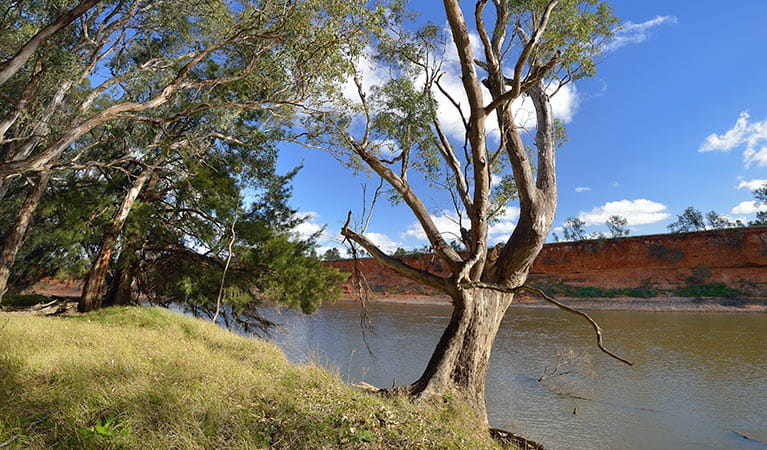
Murrumbidgee River flows in a westerly direction and is over 1,600km long. Murrumbidgee Valley national and regional parks access over 500km of river frontage at irrigation hubs of Narrandera, Yanco, Leeton, the plains of Maude and Hay, and the edge of the mallee at Balranald. River red gums benefit from times of flooding as it recharges the subsoil with water. The river supports river red gums forests, which in turn support the banks of the river with their root systems. Logged since the 1820s and managed as forests by the government since the early 1900s, in 2010 NSW National Parks and Wildlife Service protected 107,000ha of river red gums by creating new parks and reserves, which will now be enjoyed for generations to come.
- McCaugheys Lagoon McCaugheys Lagoon in Murrumbidgee Valley National Park is a great spot for birdwatching or a romantic picnic.
- Middle Beach This sandy Murrumbidgee River haven, Middle Beach, is an ideal place to go canoeing, kayaking, fishing, swimming or picnicking. Secluded camping spots can be found nearby.
Water, water everywhere
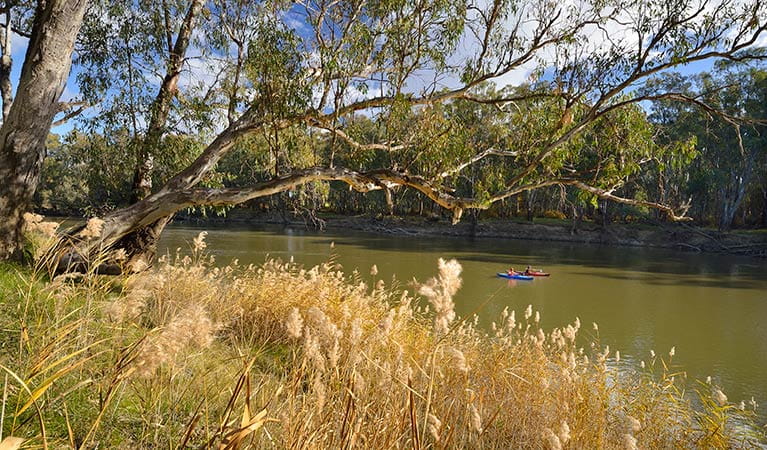
Europeans settled the area in the 1840s. By the early 1900s, private irrigation works were replaced by government projects to develop Murrumbidgee Irrigation Area (MIA). Eventually, MIA supplied water to an area of 182,000ha and enabled subdivision of grazing land into smaller units of mixed farming, horticulture, dairy and sheep. During the 1950s, Italian migrants to Australia were drawn to the area because of its similar climate and soil to Italy and became integral in the success of Riverina agriculture.
Wiradjuri people
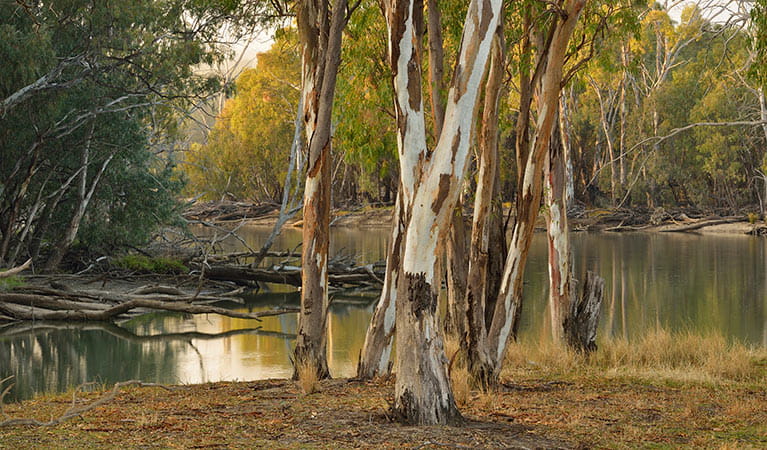
River red gums have been important to Wiradjuri people, the traditional land owners of Murrumbidgee Valley, for thousands of years. As well as being used for making canoes and shields, they also provide warmth, shelter and food. Some river red gums were large enough for individuals to sleep in, and light a small fire during the cold nights. Even today, Wiradjuri artists in Narrandera use river red gum to make boomerangs, coolamons and carved didgeridoos.
Plants and animals protected in this park
Animals
-

Southern boobook (Ninox novaeseelandiae)
The southern boobook, also known as the mopoke, is the smallest and most common native owl in Australia. With a musical 'boo-book' call that echoes through forests and woodlands, the southern boobook is a great one to look out for while bird watching.
-

Common ringtail possum (Pseudocheirus peregrinus)
Commonly found in forests, woodlands and leafy gardens across eastern NSW, the Australian ringtail possum is a tree-dwelling marsupial. With a powerful tail perfectly adapted to grasp objects, it forages in trees for eucalypt leaves, flowers and fruit.
-
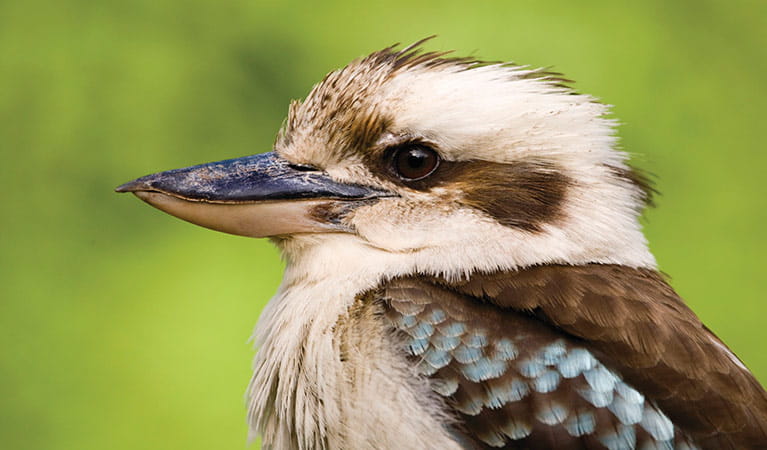
Kookaburra (Dacelo novaeguineae)
Of the 2 species of kookaburra found in Australia, the laughing kookaburra is the best-known and the largest of the native kingfishers. With its distinctive riotous call, the laughing kookaburra is commonly heard in open woodlands and forests throughout NSW national parks, making these ideal spots for bird watching.
Plants
-
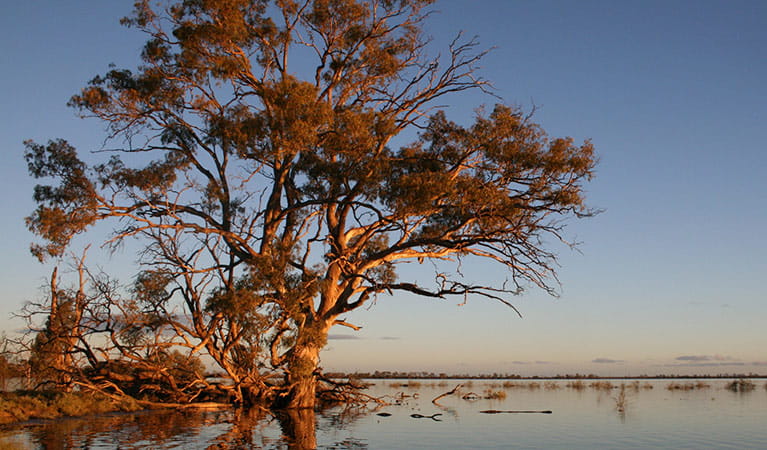
River red gum (Eucalpytus camaldulensis)
Australian native plants, majestic river red gum trees are widespread across Australian inland river systems. The river red gum is a dominant tree species of the Murray-Darling basin which spans NSW, Queensland and Victoria. This iconic native eucalypt grows to a height of 30m and is thought to have a lifespan up to 500-1000 years.
-
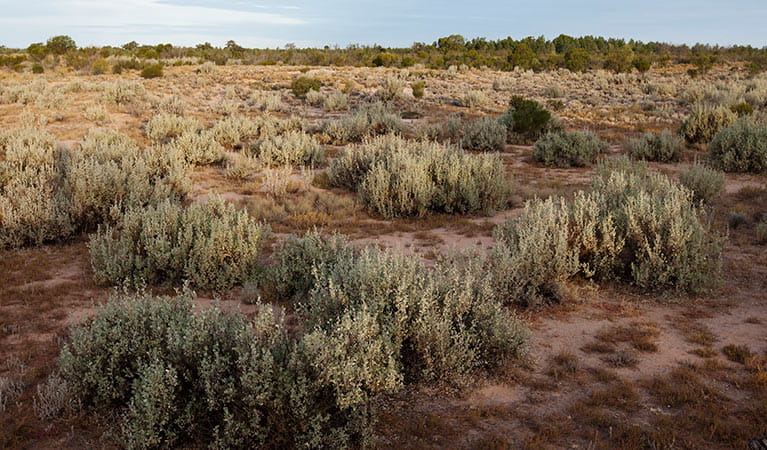
Saltbush (Atriplex nummularia)
A hardy Australian native plant, the saltbush is a small spreading shrub that can withstand dry salty soils such as those found in the desert plains of western NSW. It is grey-white in colour and has small spear-shaped succulent leaves. It flowers from December to April.

